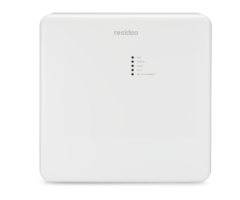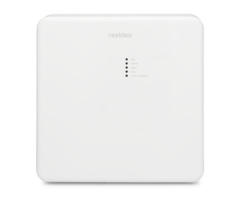How Do I Integrate a DSC Panel With Total Connect 2.0?
Older DSC panels can integrate with Total Connect 2.0 using the LTEM-P Series communicators. The AlarmNet communicator connects to the panel's keypad bus, then it pulls the zone information from the panel through that connection. Once the process completes, it's ready to integrate with TC2.
It's important to note which panels, and versions, support this integration. Currently, these panels are:
| Panel | Known Supported Revision | Known Unsupported Revision |
|---|---|---|
| DSC PC1616 | 4.24+ | 4.20 |
| DSC PC1832 | 4.62 | |
| DSC PC1864 | 4.6 |
To integrate a compatible DSC panel with Total Connect 2.0 using an LTEM-PA, LTEM-PV, LTEM-PXA, LTEM-PXV, LTEM-PIA, or LTEM-PIV communicator, follow these steps:
- Create AlarmNet360 Account. Before beginning this process, be sure your alarm dealer has created your AlarmNet360 account. Be sure to provide them with the MAC, CRC, and any other relevant information, such as your panel model number.
- Connect communicator to panel. Make sure the panel and communicator are both powered down. Connect the LTEM-P Series communicator to the DSC panel's keypad bus as shown in the image below. Once the connections have been made, you can power up the panel, but leave the LTEM-P communicator powered down for now.
-
Make sure panel is ready. In order for the communicator to sync with the panel, the panel must be in a Ready to Arm state. There can be no faults or trouble conditions present on the panel, and during the syncing process, if one of these conditions occurs, it may stop the sync. This is one reason we power the panel up first, to allow it to boot up and be sure there are no faults or trouble conditions. The following conditions will cause the communicator and panel sync to fail:
- Installer Code - If the Installer Code in the panel does not match the Installer Code associated with the AlarmNet account, the sync will fail. Below you can see how to change the Installer Code at the Panel, or via AlarmNet360 so that they match.
- Wiring - Verify that the wiring between the communicator and the DSC panel is correct. A reversal of the Green and Yellow wires or a missing Black wire will cause the sync to fail.
- Alarm - An alarm or alarm memory on the DSC panel will also cause the sync to fail. To clear an alarm, Arm and then Disarm the system.
- System Armed - The system must be both Disarmed, and Ready to Arm before the sync can be completed successfully.
- Menu Mode - The system must not be in any menu-driven field, including panel programming. If the panel is in programming, press the [#] key until the display shows Disarmed, Ready to Arm.
- General System Trouble - A general system trouble could be caused by a PC5204 Power Supply Module, or by a PC5400 Printer Module. Per Resideo, when using the PC5204 if a trouble condition is generated, try tying a 1k resistor from terminal O1 to AUX. If Output #1 is unused, verify that the wires between the panel and the module are good using a multimeter. Information for clearing specific troubles can be found in this guide.
- General System Tamper - This is caused by a tamper being faulted on one of the auxiliary modules. Be sure that all covers are securely in place. On expansion modules, you may be able to trick the panel into clearing a tamper by tying a 1k resistor between the Tamper terminal and Ground on the module. These tampers cannot be disabled via panel programming.
-
Power up the communicator. Now you can connect the communicator's power adapter to an outlet and then connect its battery using the battery wires supplied. Be sure not to exceed the wiring limits between the power adapter and the communicator, based on wire gauge:
Maximum Wire Length Wire Gauge 25 Feet (7.62m) #22 AWG 45 Feet (13.72m) #20 AWG 70 Feet (21.34m) #18 AWG 110 Feet (33.53m) #16 AWG -
Reset the communicator. Press and hold the communicator's Test button for ten (10) seconds, then release. This performs a soft reboot of the communicator. When the reboot is complete, the communicator should enter DSC panel programming and retrieve all zone and partition information. While this is happening, the communicator's LEDs will flash in sequence from top to bottom. The DSC keypads should show that the panel is busy, or in programming. When the communicator first resets, it will send an E355 message to AlarmNet. The sync can take up to ten (10) minutes, depending on the panel programming. Do not touch any panel keypad keys during this time.
If the sync fails, after ten (10) minutes the communicator's Fault LED (Red) will begin to blink and another E355 message will be sent to AlarmNet. Go back through the previous steps to be sure the Installer Code and wiring are correct, then perform Step 5 again. If the sync is successful, an R355 will be sent to AlarmNet. - Test operation. Once the communicator and the panel have synced, you're ready to test signals and Total Connect 2.0 operation.

Probably the single most important step in successfully integrating a DSC panel with Total Connect 2.0 through one of the ProSeries communicators is making sure the Installer Code in the DSC panel matches the Installer Code in the communicator/AN360. The communicator has the default Installer Code of 5555 programmed. Whenever possible, be sure the Installer Code in the DSC panel matches this. If you know the current panel Installer Code, you can change it to the default through keypad programming. Fortunately, the steps to change the Installer Code are the same for all three (3) of the above-referenced DSC Panels.
Changing the Installer Code Via Panel Keypad Programming:
- Enter programming by pressing [*] + [8] + [Current Installer Code].
- The Lock Icon will light solid once you have entered programming successfully. On a full English display keypad, you should see "Enter Section". On a fixed English display keypad, the word Program will flash on and off on the display.
- Once in programming, press 006. On a full English display keypad, it should say "Enter Data" and show the current Installer Code entry. On a fixed English keypad, not much will change.
- Enter 5555, this changes the Installer Code to 5555, which is the default and will match the Installer Code in the communicator. The keypad will beep an acknowledgment. On a full English keypad, you will see the new Installer Code as you enter it. On a fixed English keypad, nothing will change, you will only hear the beep to acknowledge that the entry has been accepted. On the full English keypad, it will then return to the display of "Enter Section". If you press 006 again, you can verify that the new Installer Code was entered properly. On a fixed keypad, there is no way to verify what you have entered, and if you exit programming having made a mistake in the code's entry, you will not be able to get back into programming without defaulting the panel. And possibly, not even then. This is why it is always recommended to use a full English keypad for programming.
- Once you have successfully changed the Installer Code, and hopefully verified that it has been entered correctly, you can exit programming by pressing the [#] key repeatedly until the system shows the current status.
If you know the current Installer Code in the DSC panel and you don't want to change it back to default, it is possible for your dealer to change the Installer Code in the Communicator via AlarmNet360.
Changing the Installer Code Via AlarmNet360:
- The alarm dealer must log into AlarmNet360 and pull up the proper account.
- In the programming screen, go to Edit > Settings > Set Installer Code. Enter a code that matches the Installer Code in the panel.
- Once the panel's current Installer Code has been entered into AlarmNet360, there is no need for the dealer to perform a "Send Data" command.
- Reboot the communicator by holding down the Test button for ten (10) seconds, then releasing it. The communicator should reboot and then begin the syncing process. Remember, once this process begins, it can take up to ten (10) minutes. During this time, do not touch any keys on any of the panel's keypads.
Did you find this answer useful?
We offer alarm monitoring as low as $10 / month
Click Here to Learn MoreRelated Products


- Answered
- Answered By
- Julia Ross
